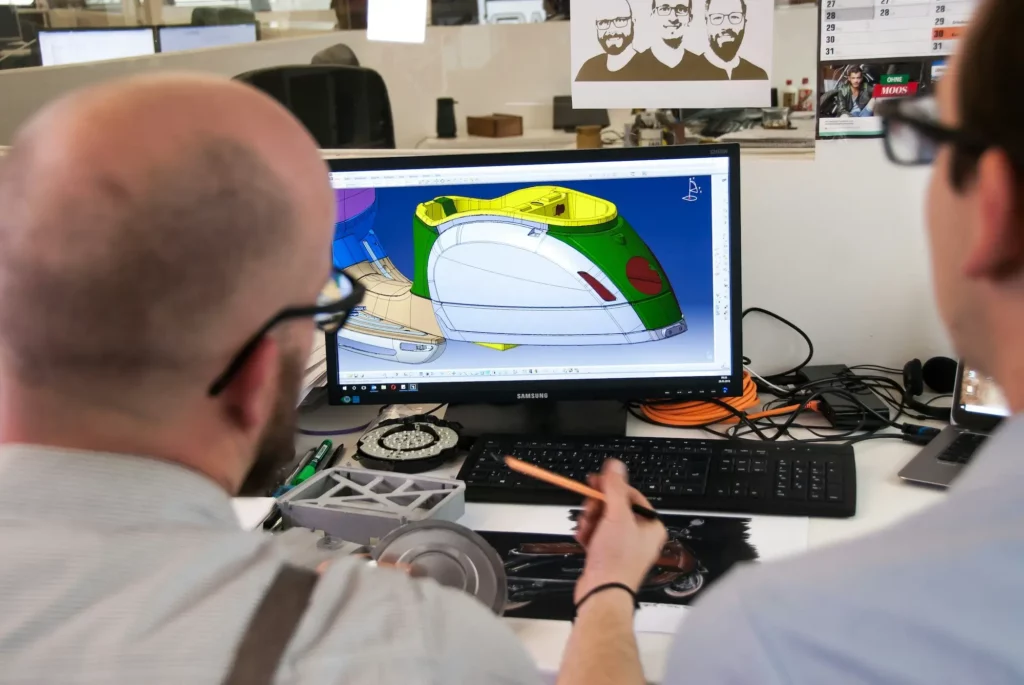Video meetings are now part of everyday business. Whether you’re talking to your team, meeting with clients, or checking in with partners, a good setup makes a big difference.
That’s why choosing the right video conferencing tool matters. A good platform helps you talk clearly, share updates easily, and stay on the same page with your team.
In 2025, there are plenty of video conferencing platforms to choose from. Let’s go over the top 5 picks that offer the best mix of ease of use, solid features, and reliable performance for everyday meetings.
5 Video Conferencing Solutions in 2025
There are many meeting platforms that you can use. The right one depends on how you use it. Here are a few options based on different needs:
1. CADchat for CAD Design Review Meetings
CADchat is a cloud-based platform made for product teams that work with CAD files. It helps engineers, designers, manufacturers, and even non-technical team members stay aligned.
You can view and comment on CAD models without screen sharing, avoid version mix-ups, and get faster approvals.
Key Features
- Live CAD model reviews – Open and work on 3D CAD models in real time without screen sharing or file conversions
- Asynchronous collaboration – Leave comments directly on CAD models so teammates can respond when they’re available
- Persistent digital workspaces – Keep all files, feedback, and decisions organized in one place for easy access
- Non-technical accessibility – Let stakeholders and suppliers who don’t use CAD tools view models and give clear feedback
- Smart version control – Work on the most recent file version and track changes without worrying about lost revisions
Collaborate across teams and file types without slowing down. Start using CADchat.
2. Microsoft Teams for General Meetings
Source: microsoft.com
Microsoft Teams is a simple platform that lets you chat, join meetings, share files, and use apps. Everything is in one place.
It supports remote and hybrid work environments by offering tools for real-time interaction, task management, and team coordination.
Key Features
- Unified communication tools – Combines chat, video, file sharing, and meetings in one platform
- AI-generated meeting support – Offers features like real-time summaries and smart note-taking with Copilot
- Flexible plans for different users – Available for small businesses, enterprises, schools, and home users
- Integrated Microsoft 365 apps – Connects with Word, Excel, PowerPoint, and other Microsoft tools
- Customizable meeting experiences – Includes tools like PowerPoint Live, Whiteboard, and meeting templates
3. Google Meet for Daily/Weekly Standups
Source: workspace.google.com
Google Meet is a video communication platform that supports virtual meetings, video calls, and real-time collaboration.
It works across devices without requiring software installation and is integrated with Google Workspace tools like Docs, Sheets, and Slides.
Key Features
- Cross-device accessibility – Join meetings from a web browser or the mobile app without downloading extra software
- Workspace integration – Start meetings directly from Google Docs, Sheets, and Slides for in-context collaboration
- AI-powered support with Gemini – Use features like real-time translated captions, automatic note-taking, and visual enhancements
- Interactive meeting options – Share YouTube videos, play games, and use emoji reactions during calls
- Privacy and security protections – Includes default encryption, entry controls, and anti-abuse features
4. Slack Huddles for Quick Chats and Updates
Source: slack.com
Slack Huddles is a built-in feature within Slack that allows team members to connect instantly through audio or video.
Designed to create the feeling of working together in the same room, Huddles supports live screen sharing and real-time collaboration.
Key Features
- Instant audio and video connection – Start a Huddle directly in Slack without leaving your workspace
- Screen sharing support – Share your screen live to collaborate on documents, presentations, or tasks
- Automatic AI note-taking – Capture meeting highlights, action items, and speaker attributions without manual effort
- Saved content for reference – Keep all shared files, messages, and links in Slack after the Huddle ends
- Expressive meeting features – Use emoji reactions, backgrounds, and effects to add energy to conversations
5. Cisco Webex for Hosting Webinars
Source: webex.com
Webex Meetings is a video conferencing platform designed to support hybrid work and team collaboration. It combines meetings, messaging, calling, and integrations into one system.
The platform supports a wide range of devices and offers features for both live and asynchronous communication.
Key Features
- Real-time translation and noise removal – Supports multiple languages and reduces background noise for clearer communication
- Cross-device meeting access – Allows users to join and move meetings between desktop, mobile, and car systems
- Integrated virtual assistant – Automates tasks like note-taking and action item capture during meetings
- Control Hub for IT management – Provides centralized user, device, and analytics management with built-in security
- Interactive presentation tools – Includes features like polling, custom views, and immersive content sharing for audience engagement
What to Consider When Arranging a Video Conference
Planning a video conference can be simple if you know what to look out for. Whether you’re meeting with your team or speaking with partners, a few steps can help your meetings feel smooth and productive.
Here’s what to consider.
Choose the Right Video Platform
Start by picking a platform that works well for your team. Look for one that’s easy to join from different devices, whether it’s laptops, tablets, or phones. The platform should allow clear video, screen sharing, and easy access for all attendees.
Think about security, too. You want a platform that keeps your calls secure, so only invited people can join. A good platform also helps you manage invitations, set reminders, and record action items if needed.
Use the Right Technology to Stay Organized
Technology plays a big part in how well your meetings go. Make sure your video setup delivers seamless audio, even in large rooms. A good microphone array and solid speaker system help everyone hear each other without problems.
Use shared calendars to schedule calls. This keeps your whole organization in sync and helps avoid double bookings or missed meetings.
You can also use project tools to track who’s doing what after the meeting ends. This keeps the team moving forward and makes the most of everyone’s time.
Test Your Equipment
Before the meeting, test your setup. Check the camera, speaker, and microphone array to make sure everyone will be seen and heard clearly. This step helps avoid last-minute issues.
Use HDMI cables to connect to larger screens if you’re in meeting rooms. That way, everyone can see shared content without crowding around one screen. Also, make sure the internet connection is strong and stable to avoid delays or dropped calls.
Determine the Conference Room Size You Need
Think about how many people will join in person and how many will join online. For small team rooms, you may only need a basic setup with a webcam and a speakerphone. For bigger groups, explore options that cover a wider range of room sizes.
Some spaces may need extra gear like ceiling mics or wall-mounted screens. The right setup depends on your needs, but the goal is the same: make it easy for everyone to be part of the conversation, no matter where they are.
Set Meeting Rules and Agenda
A clear plan helps the meeting stay on track. Before you start, share the agenda with everyone. Let them know what will be covered and what they should prepare.
Set a few simple rules, like keeping microphones muted when not speaking or raising a hand to talk in large meetings. This keeps the conversation clear and makes sure all voices are heard.
Meetings with structure often lead to more focused discussions and useful action items. Everyone leaves knowing what to do next. That helps your team stay productive.
Collaborate in Real Time with CADchat
CADchat helps product teams focus on solving problems during engineering design reviews instead of chasing screenshots or scattered feedback. Your CAD model becomes the meeting space, where feedback sticks to the design and everyone stays aligned.
No more guessing what someone meant on a screen share or losing decisions in Slack threads. Everything is clear, visible, and tied to the work. It takes just a few minutes to get started. There are no installs, no IT tickets, and no extra steps.
Whether you’re working with engineers, suppliers, or non-technical stakeholders, CADchat keeps your team connected and your designs moving.
Turn your review process into a competitive advantage. Get started with CADchat today!
FAQs About Video Conferencing Solutions
What are the 5 best video conferencing software?
Some well-known video conferencing solutions include Zoom, Microsoft Teams, Webex Meetings, Google Meet, and Cisco Meeting Server. For CAD production, CADchat is the top choice.
These platforms support hybrid work, let teams connect from any room size, whether it’s a huddle room or a medium room, and offer collaboration tools like screen sharing, calling, and recording to boost productivity.
Which tool is best for video conferencing?
The best tool depends on your setup and what your team needs, but Zoom and Microsoft Teams are solid picks for most businesses.
Zoom works great in any room and offers high-quality video conferencing with smart features like remote control and AI-powered backgrounds, while Teams shines in Microsoft-based offices with deep integration, intuitive controls, and seamless collaboration.
Is Zoom the same as video conferencing?
Zoom is one of the most popular video conferencing solutions, but it’s just one option out of many. It’s a platform used for video meetings, calling, and team collaboration.
It doesn’t represent the whole category of conferencing solutions, which also includes platforms like Webex, Microsoft Teams, and others built to connect teams across devices and space.
What are the three types of video conferencing systems?
Video conferencing systems usually fall into three types: desktop-based (like Zoom or Teams on a laptop), room-based systems (like Cisco or Logitech setups for conference room use), and integrated hardware bundles built for specific room sizes, like a huddle room or medium room.
These systems help teams connect easily, with displays, microphones, and video bar devices that support remote work and meetings with clear audio quality and engagement.


